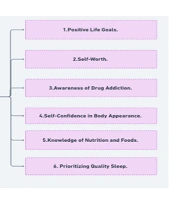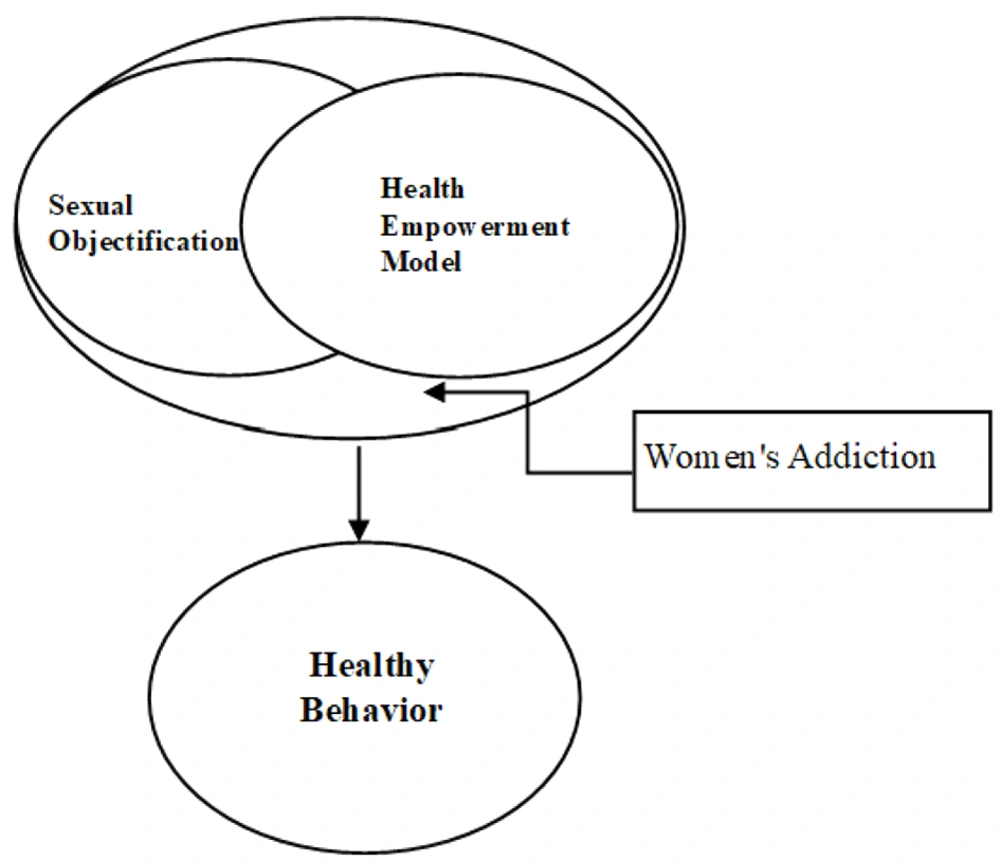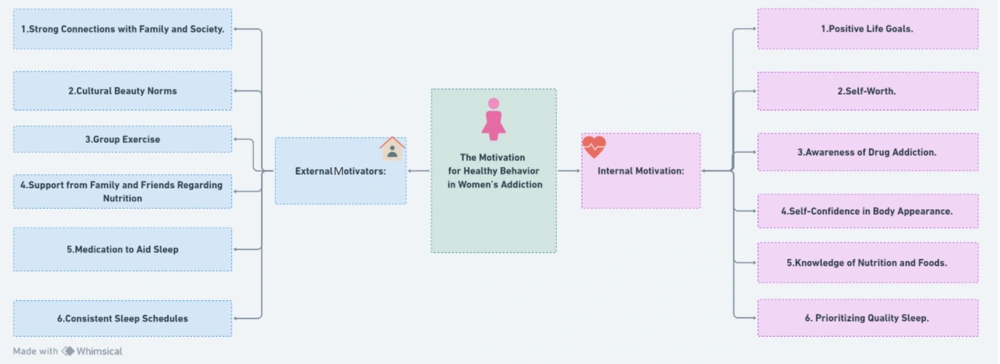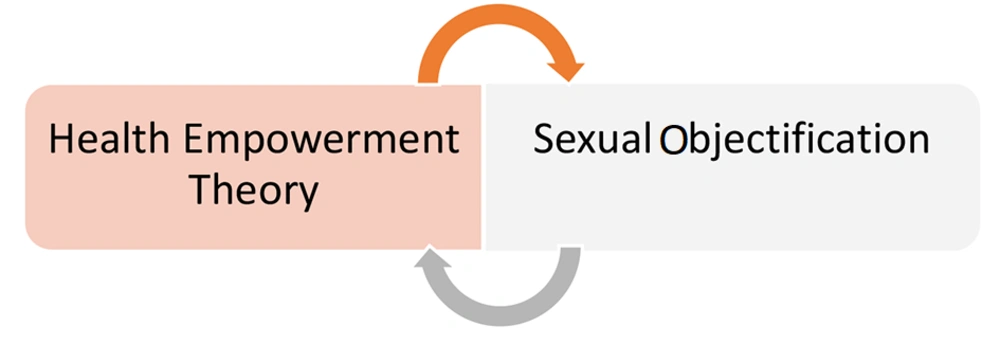1. Background
In recent years, the number of women addicted to drugs in Thailand has been steadily increasing. Data from 2021 to 2023 indicate an 8% rise in the number of women entering drug treatment and rehabilitation, with women arrested and entering treatment accounting for 38% of those receiving care. Research on women who use drugs remains limited compared to men, despite the significant health impacts observed among women. Studying health empowerment models can emphasize the importance of personal and social resources in promoting health behaviors specifically targeted at women who use drugs. This underscores the need for a more comprehensive understanding of their health behaviors, presenting a significant challenge in coordinating efforts between government and private sectors to address the drug crisis.
The integration of the health empowerment model and the concept of gender objectification highlights complementary approaches to promoting health among women who use drugs. The health empowerment model emphasizes that positive health behaviors result from both internal and external factors, including social and cultural influences related to gender. Women can leverage these factors to build positive power to manage their health. Conversely, the concept of gender objectification focuses on women's attention to their body shape and appearance, particularly their interest in beauty. By integrating these two concepts, the approach aims to help women with substance use problems prioritize and improve their health, fostering a healthier lifestyle, as illustrated in Figure 1.
2. Objectives
This qualitative research explored the health behaviors of women who use drugs. The research design was tailored to accommodate women with diverse experiences of drug use.
3. Patients and Methods
In-depth interviews were conducted to gather rich insights from the participants. Purposeful sampling was employed to select informants with direct experience or relevant knowledge, including women with substance use problems, caregivers, and medical professionals, totaling 10 volunteers. Measures were implemented to ensure participants felt comfortable and open, including protecting confidentiality, obtaining informed consent, and managing potential risks or distress. Approval for data collection was obtained from the ethics review board of the university and the participating hospitals. Content analysis was conducted to examine the data, with checks for reliability. The study aimed to understand how women who use drugs navigate their experiences and motivations, focusing on intrinsic and extrinsic factors influencing their perceptions of health care through interpretative analysis.
4. Results
4.1. Background and General Information
This study focuses on the experiences of women with substance use, including former addicts in rehabilitation and healthcare professionals. Data were collected from 10 female informants aged 26 to 51 years. Among them, five were married, three were single, one was divorced, and one was separated. Educational backgrounds varied: One woman with substance use had completed primary education, while two had finished high school. Among the former addict staff, two had completed high school, and one held a bachelor's degree. All healthcare professionals had at least a bachelor's degree.
The 10 informants were selected from various regions of Thailand: Four from the central region, two from the north, and one each from the northeastern, southern, eastern, and western regions. Their histories of substance use spanned 1 to 23 years, with common triggers including curiosity, peer pressure, stress, and weight loss. Influences from close relationships and media portrayals were also noted, as summarized in Table 1.
| Variables | No. | Age | Birthplace | Status | Education | Values | Years of Drug Use |
|---|---|---|---|---|---|---|---|
| Women with substance abuse | 1 | 27 | Northeastern | Single | High school | 3 a | 1.5 |
| 2 | 37 | Central | Separated | High school | 4 a | 20 | |
| 3 | 30 | Central | Divorced | Primary education | 2 a | 1 | |
| Ex addicts staff | 4 | 36 | Central | Married | High school | Becoming part of a peer group involved in risky behaviors, experiencing academic decline, feeling disillusioned, and subsequently turning to substance use due to peer influence. b | 3 c |
| 5 | 26 | Western | Married | High school | During adolescence, having a relatively overweight physique, seeing an older sister use drugs and subsequently lose weight, leading to a desire to use drugs to become thin. b | 6 c | |
| 6 | 45 | Northern | Single | Bachelor's | Starting to use since adolescence because of the desire to try it, following friends. b | 23 c | |
| Healthcare professionals | 7 | 38 | Eastern | Single | Bachelor's | Conducting psychological assessments or tests for individual and group therapy purposes. d | 15 |
| 8 | 35 | Northern | Married | Bachelor's | Organizing rehabilitation activities for patients and supervising the rehabilitation process, both for patients in the medication rehabilitation phase and those in the functional recovery phase. d | 11 | |
| 9. | 40 | Southern | Married | Bachelor's | Caring for substance use disorder patients in terms of treatment, both in the medication rehabilitation phase and the functional recovery phase, as well as providing counseling to the patients and their families. d | 22 | |
| 10. | 51 | Central | Married | Bachelor's | Conducting clinical psychological tests to assess patients and designing a tailored rehabilitation process suitable for the patients. d | 28 |
Background and General Information about Ex-addict Staff, Women with Substance Abuse Issues, and Healthcare Professionals
4.2. The Motivation for Healthy Behavior
When analyzing and integrating the internal and external motivations of drug users, the findings can be categorized into the following sub-topics:
4.2.1. Internal Motivation
4.2.1.1. Positive Life Goals
Setting positive life goals is crucial for women struggling with drug addiction, as it can inspire them to overcome their addiction. While specific goals may vary from person to person, they serve as powerful motivators for women to break free from substance abuse and embark on a new path. For example, nurturing dreams of a better future, striving for self-improvement to enhance their health, and seeking acceptance and support from loved ones are all motivating goals. By focusing on these objectives, women can tap into the resilience needed to overcome their challenges related to drug use.
“If she has clear life goals, things seem simpler. I once met a female patient who had just given birth and loved her child deeply. Her child was only 3 or 4 years old, and she felt terrible about being arrested. She had to stay in the hospital for 4 months, unable to see her child. That experience made her promise to never use drugs again, no matter what, because using drugs meant she wouldn't be there for her child” (No. 10).
4.2.1.2. Self-Worth
Acknowledging self-worth is crucial for women struggling with drug addiction. Emotional challenges such as mood swings, anger, or depression resulting from substance abuse can diminish a woman's sense of value. However, by acquiring new skills relevant to daily life or the workplace, women can rebuild their confidence. Achieving personal goals and continually improving themselves helps them develop a more positive self-image and recognize their intrinsic worth.
“I asked to stay longer to take care of myself, build confidence, and recognize my worth. It's about changing my life. Being here gives me opportunities, like continuing education, NFE, or vocational training. If I get through this, I could even have a career. But if I leave too soon, before my mind is strong, I’ll likely come back. I'm getting older, and I don't want to waste time” (No. 2).
4.2.1.3. Awareness of Drug Addiction
Understanding the consequences of drug addiction is crucial. It is important to recognize the harmful effects of prolonged substance abuse, which can lead to physical deterioration, weight loss, and visible signs of distress. Initially, some women may view drug use as a way to lose weight, but over time, they come to realize its damaging impact on their health. This awareness often becomes the driving force behind their decision to quit, with the goal of restoring their well-being.
“My body started off in bad shape, with no energy at all. When I wasn’t using it, I just felt drained and couldn't even help myself” (No. 4).
4.2.1.4. Self-Confidence in Body Appearance
The desire to maintain physical appearance and health can be a powerful motivator for women who use drugs. Many women initially turn to drugs in an attempt to achieve a certain body shape or conform to societal beauty standards. However, when they achieve these goals through healthier practices like exercise and balanced nutrition, they often experience a boost in self-confidence and greater satisfaction with themselves.
“Some people used to think being thin and having a good figure was important for attracting attention. I turned to drugs because I wanted to be slim, but when I stopped, I gained weight. Now, without drugs, I focus on my health through exercise and diet control. That’s the only way to stay fit and healthy” (No. 7).
4.2.1.5. Knowledge of Nutrition and Foods
Understanding nutrition and consuming foods that promote health are essential for overall well-being. A balanced diet that includes a variety of food groups—such as carbohydrates, proteins, fats, vitamins, and minerals—in the right proportions is key to maintaining good health. Moreover, managing calorie intake is crucial for achieving and maintaining a healthy weight.
“The main focus is on physical health and body proportions. Eating nutritious food helps nourish and repair the body” (No. 1).
4.2.1.6. Prioritizing Quality Sleep
Engaging in relaxation activities before bedtime can greatly improve sleep quality. Practices like meditation and mindfulness promote a calm and peaceful mental state, helping to reduce stress and anxiety—key factors for individuals in recovery.
“Spending 15 minutes praying is like 15 minutes of meditation. It helps clear her mind, making her feel more relaxed and sleep better” (No. 3).
In summary, setting positive life goals, recognizing self-worth, understanding the consequences of drug addiction, maintaining good physical health, and prioritizing quality sleep are essential for women working to overcome drug addiction and build a brighter future. These factors are key in motivating and supporting women as they strive to overcome addiction and rebuild their lives.
4.2.2. External Motivators
4.2.2.1. Strong Connections with Family and Society
Building strong connections with family and society is essential for helping women overcome drug addiction. When women who use drugs feel supported and embraced by their loved ones, friends, and community, they are more likely to break free from isolation and find the encouragement needed to stop using drugs. It is important to note that standards of beauty can vary greatly across different cultures and time periods.
“Sometimes patients may not want to quit drugs, but support from understanding family members and a positive environment can give them hope and motivate them to set goals to quit” (No. 8).
4.2.2.2. Cultural Beauty Norms
These standards are often closely linked to the values and beliefs of a particular society. In some cultures, physical appearance, such as body shape, plays a significant role in defining beauty. For some women struggling with drug addiction, striving to meet these beauty standards can serve as a motivating factor in their efforts to enhance self-confidence and self-esteem.
“Exercise is great for your health and helps keep your body strong, which is something many women focus on. However, for drug patients, it’s less common to see exercise as a way to build strength. Instead, it’s often tied to wanting to look good, be accepted by others, or gain confidence—like seeking approval from a boyfriend or society. Society places a high value on beauty, and patients likely see beauty as important too” (No. 5).
4.2.2.3. Group Exercise
Participating in group exercises with friends is an effective way to find motivation and make physical activity enjoyable. Engaging in a variety of activities with different equipment, accompanied by music, turns exercise into a fun experience that fosters both a social and motivating environment.
“When she's alone, doing aerobic dance isn't much fun, so she tries to make it enjoyable. Having a leader helps motivate her and encourages others in the group to join in. Sometimes she helps out, like counting along. But if there's just music without a video to follow, she doesn't feel as motivated” (No. 9).
4.2.2.4. Support from Family and Friends Regarding Nutrition
During treatment at state rehabilitation facilities, individuals may be provided with prescribed meals. However, there are times when family and friends bring outside food as a way of offering support.
“I'll help him plan for when his relatives visit, like bringing different types of food, such as salty pork, fried pork, or fried chicken, so he can enjoy a variety of meals and not feel bored. If relatives can't visit, I’ll suggest sending parcels or providing canned food as an alternative to the repetitive meals from the kitchen” (No. 4).
4.2.2.5. Medication to Aid Sleep
Such support can serve as a motivating factor for women as they progress in their recovery journey, helping them maintain a healthy lifestyle. Depending on an individual's health status and specific needs, healthcare professionals may prescribe sleep medication to address both the physical and psychological symptoms associated with addiction.
"During the recovery period, the doctor will adjust the medication, avoiding morning doses. For those without severe mental symptoms, the dosage is reduced to just before bedtime to prevent daytime drowsiness” (No. 6).
4.2.2.6. Consistent Sleep Schedules
Maintaining consistent sleep patterns, as practiced in state rehabilitation facilities—such as waking up at set times—helps individuals establish healthy sleep routines that promote overall well-being. Additionally, creating a dark and quiet sleep environment by turning off lights at a specific time signals to the body that it is time to rest. These external motivators can significantly influence women as they work to overcome drug addiction and seek support from rehabilitation facilities.
“Having a regular sleep schedule means following a typical sleeping routine, like most people. In rehab, patients are given a daily activity schedule designed to resemble a normal lifestyle. This helps adjust irregular habits they had before therapy, like eating and sleeping at odd hours—sometimes going to bed as late as 1 or 2 a.m. The rehab schedule sets a consistent routine, such as going to bed around 8:30 - 9:00 p.m. and waking up at 6:00 a.m.” (No. 8).
Internal motivators include setting positive life goals, recognizing self-worth, understanding the consequences of addiction, maintaining good physical health, and prioritizing quality sleep. External motivators encompass strong family and social connections, adherence to cultural beauty norms, participation in group exercise, support for proper nutrition, the use of sleep medications, and maintaining consistent sleep schedules. These factors are illustrated in Figure 2.
5. Discussion
This study highlights the crucial role of strong intrinsic motivation in supporting the integrated theoretical framework, emphasizing the importance of health care for women who use drugs. Self-awareness plays a key role in enhancing health empowerment. The findings indicate that effective goal setting aids in successful decision-making to quit drug use, promoting positive self-transformation (1). Extrinsic motivations, such as hope and readiness to change, also significantly influence women’s decisions to quit using drugs. Developing new skills fosters positive self-perceptions and beliefs in their ability to succeed in various aspects of life (2). Furthermore, understanding the negative physical impacts of drug use motivates women to prioritize good health. For instance, recognizing the benefits of eating a balanced diet aids in the recovery process, helping the body function properly (3). Support from family and friends also plays a vital role in encouraging women to quit using drugs, underlining the importance of emotional and social support (4, 5). Building relationships with family and society provides an essential foundation for women striving to overcome addiction (6).
Cultural perceptions of gender objectification and beauty standards differ across societies (7). In Thai culture, physical beauty significantly influences women's self-confidence and social status, driving some to pursue certain appearances for social acceptance (8). The health empowerment model provides insights into key motivations among women who use drugs, such as exercising to maintain self-esteem. However, addressing underlying misconceptions is crucial for fostering sustainable health behaviors. The findings of this study have implications for health care practices and policymaking aimed at improving the health and well-being of women who use drugs.
Despite its contributions, the study is limited by the diversity of drug use patterns among women and the focus on an urban community, which may not fully reflect the context in other communities. Future research should explore these variations to deepen our understanding. In conclusion, promoting gender equality and autonomy is essential in addressing women’s drug addiction, with a particular focus on the interaction between sexual objectification and health empowerment (Figure 3).



